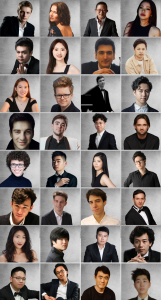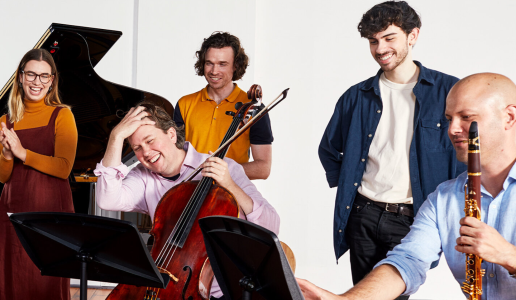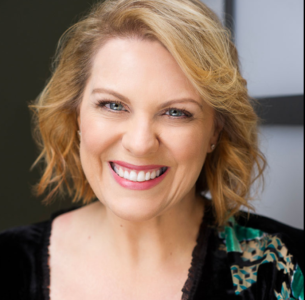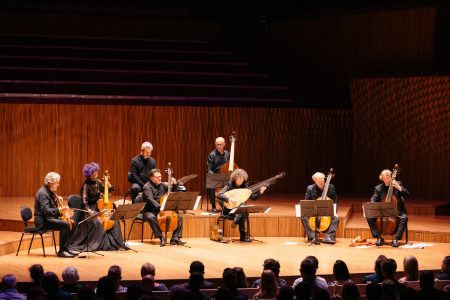Latest news
The Sydney International Piano Competition Announces 2023 Participants
The names have been announced of 32 fine young pianists from around the globe who will take part in the Sydney International Piano Competition (The Sydney), in July, 2023.
Omega Ensemble Announces 2023 CoLAB Composers
Omega Ensemble announces its CoLAB: Composer Accelerator Program participants for 2023, selected after a competitive national selection process.
Universal Music Group Acquires Hyperion Records
Universal Music Group (UMG), has announced the acquisition of the renowned British classical label Hyperion Records.
Jacqueline Dark Is Back From ‘The Void’
Jacqueline Dark, the irrepressible star of opera, music theatre and cabaret is performing a comeback show in March dedicated to and inspired by the friends who supported her through an extraordinarily difficult time over the last year.
Madeleine Easton To Play At Coronation
Australian violin virtuoso and founder of the Bach Akademie Australia, Madeleine Easton is to play at the Coronation of King Charles III with the English Baroque Soloists and Monteverdi Choir under the direction of Sir John Eliot Gardiner, her long-time mentor and patron.
Sophie Kauer Releases Unsung On Deutsche Grammophon
Cellist Sophie Kauer, the Breakout Star of TÁR will release her debut EP in March on the Deutsche Grammophon label.
Latest reviews
Concert Review: Splendour And Mystery/Sydney Chamber Choir
Splendour and Mystery/ Sydney Chamber Choir
Verbrugghen Hall, Sydney Conservatorium of Music
Australian Digital Concert Hall
25 March, 2023
In Splendour and Mystery, Sydney Chamber Choir under the direction of Sam Allchurch joined forces with Camerata Antica led by Matthew Manchester and organist Thomas Wilson in an adventurous anthology of music written for double choir. Specialising in the music of the 16th and 17th centuries, the founder of Camerata Antica, Matthew Manchester playing the fiendishly difficult cornetto, was joined by Michael Wyborn, William Kinmont and Paolo Franks playing the equally challenging alto, tenor and bass sackbutts respectively.
Bookended with pieces by Giovanni Gabrieli with one of his refreshing Canzonas in the middle, the program also contained music by living Australasian composers Clare Maclean and Brooke Shelley, Gabrieli’s contemporary and student Heinrich Schütz and 20th century composers John Tavener and Frank Martin. Together these composers explore and exploit the potential of the double choir with its opportunities for super-rich harmonies, added melodic lines, imitation, choral interplay and variations in the positioning of the singers.
The opening motet, Gabrieli’s Jubilate Deo omnis terra, C 65 was quite literally a musical shout for joy. A major part of this journey back in time to Renaissance Venice was the unique sound of Camerata Antica. Heralded by the instruments, the 10 lines of the choir sang an uplifting, lively and tightly dotted chorus, alternating with homophonic passages. Allchurch and his ensemble clearly delineated the rhythms, changing time signatures, hemiolas and other displaced accents which created the buoyancy of this celebratory piece.
John Tavener’s brilliant A Hymn to the Mother of God transcends the mortal and looks to the cosmic powers of Mother Mary. Writing in the style of canon, with imitative lines that start in quick succession and not necessarily in harmony, Tavener creates a sense of ‘other-worldliness’ in this simple but awe-inducing piece in three-sections. It was a slow burn as the two choirs sang with shimmering lightness and a sense of spinning through space, creating vivid colours and clusters of clashing chords with impressive control as the voices rose in range and dynamic to its full-bodied climax.
The program moved imperceptibly to the German Magnificat by Heinrich Schütz, as the choirs were joined by organ and instruments. This was a relevant and important inclusion as Gabrieli himself taught Schütz in this multi-choral technique which Schütz then developed in his own style.
Clare Maclean’s moving Christ the King was sublimely sung, opening in the manner of a plainchant by the female voices which peeled off into mirroring phrases by the other voices, ending in a reprise of the plainchant. Premiered by this choir in 1984, it is precisely opportunities like these which new composers need for their music to be heard and re-heard until it becomes recognizable to listeners and enters the DNA of the concert repertoire.
The short and brilliant burst of Gabrieli’s Canzona seconda, C 187 from Camerata Antica showcased these rudimentary instruments in all their imperfect glory as the choir positioned itself for Frank’s only unaccompanied choral work, the demanding Mass for double choir, considered to be one of the finest and most complex pieces of 20th century choral music. The choir did ample justice to this piece which incorporates the aesthetics of Renaissance music, French Impressionism, Schoenberg’s twelve-note system and J S Bach. The altos began the Kyrie with a freely-flowing, supplicating melody; the Gloria built step-wise to cluster chords; the Credo was a business-like affirmation of faith; the canon-styled Et Resurrexit was levity, hope and word-painting to perfection; the Sanctus introduced softer harmonies from the male voices. The mass, Version 1, ended with a powerful Benedictus. Fast forward to 1926 and Martin added the Agnus Dei, the crowning glory to this choral magnum opus. The mass culminated in a glorious unification of the choirs.
Brooke Shelley’s Heavenly Father, composed in 2022, performed in the presence of the composer was premiered in November 2022, by the Sydney Chamber Choir. A lyrical and beautifully textured piece, it is very pleasing that it has quickly been programmed again. Like the slightly older piece by Maclean, it is critical that new pieces of merit such as these, are given regular and frequent hearings so that they may be heard widely and face the test of time.
Finally, Gabrieli’s Magnificat a 14, C 79 brought together the full instrumental and vocal forces of the ensemble. Using the 16th century Venetian technique of cori spezzati (split choirs), the brighter sound of the female voices and cornetto took to the left gallery with the male voices and the thrilling grunt of the bass and other sackbutts in the right gallery with a mixed ensemble placed and organ placed centrally on stage.
This was an intelligent and audacious program from Allchurch, performed with glorious sound by a choir secure in technique, pitch and musicianship.
Concert Review: Savall & Hespèrion XXI
The performance by living legend Jordi Savall and his early music ensemble Hespèrion XXI in the Concert Hall of the Sydney Opera House not only entertained and transfixed the auience, it was a masterclass in early instrumental performance and a rare opportunity to hear an expert ensemble of early instuments playing this specialist repertoire.








